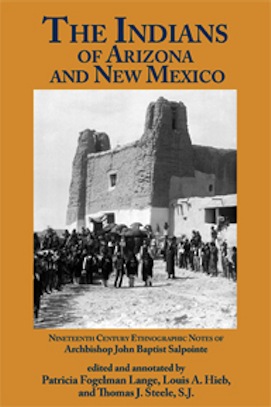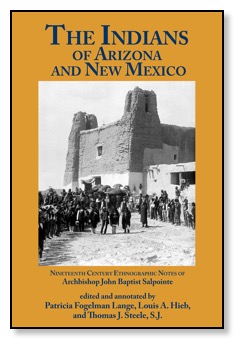Nineteenth Century Ethnographic Notes of Archbishop John Baptist Salpointe
by Patricia Fogelman Lange, Louis A. Hieb, and Thomas J. Steele

392 pages 26 illustrations
$19.95/PB (978-1-890689-57-5)
This volume describes the little-known world of John Baptist Salpointe, successor to Archbishop Lamy and the second Archbishop of Santa Fe, who worked among Indian tribes in both Arizona and New Mexico during the tumultuous final years of the frontier between 1860-1898. All of his impressions and accumulated knowledge of Indian/White relations over this thirty-plus-year period are vividly described in his varied vignettes enhanced by the editors through extensive annotations contributing to a broader historical background for the reader. Portrayed here is the growth of this church dignitary from a young French priest who volunteered to live in the desolate Southwest to a resourceful man of strong will and determination as he encouraged the expansion of parishes, created religious schools, hospitals, and parishes, attended Indian ceremonies, and collected tribal statistics, tribal history, and folk tales from informants. This book will have special historical appeal to those readers interested in the frontier, Church philosophy, and Indian tribes of Arizona and New Mexico.

The Indians of Arizona and New Mexico
The Indians of Arizona and New Mexico: Archbishop John Baptiste Salpointe, D.D. (1825-1898) served the Native Americans of Arizona and New Mexico from 1859 until his death in 1898. When asked in 1872 by Archbishop Francois Norbert Blancher of Oregon to persuade the Archbishop of Baltimore to appoint an agent or board to represent Indian interests in the upcoming meeting with the Secretary of the Interior, he also requested an account of the welfare of Catholic Indians within his Vicariate. This may have been the driving force for the notes which Salpointe gathered. … The timeliness of Salpointe’s notes cannot be over-emphasized. … For the reader who might believe this volume quite formidable, the editors have provided rich introductions to each specific study. Archbishop Salpointe further included captivating stories in addition to colorful descriptions of tribal dance. The editors are to be commended for bringing forth that which would have been lost by the narrative of a relatively unknown nineteenth century missionary archbishop. — Sr. Madeleine Grace, C.V.I., University of St. Thomas, Catholic Southwest, 2017.
ABOUT THE EDITORS
Patricia Fogelman Lange, a Research Associate at the Laboratory of Anthropology Museum of Indian Art and Culture, Santa Fe, is the author of Pueblo Pottery Figurines: The Expression of Cultural Perceptions in Clay as well as a number of articles on Southwestern art and culture. Louis A. Hieb, a specialist in Hopi studies, vernacular architecture, comparative historiography and the history of photography in the Southwest, was head of Special Collections in The University of Arizona Library and director of the Center for Southwest Research at the University of New Mexico. Thomas J. Steele, S. J., a professor at Regis University and the University of New Mexico, has been active researcher of the religious culture of the people of the Southwest and is the author of numerous books on the religious art of New Mexico.

